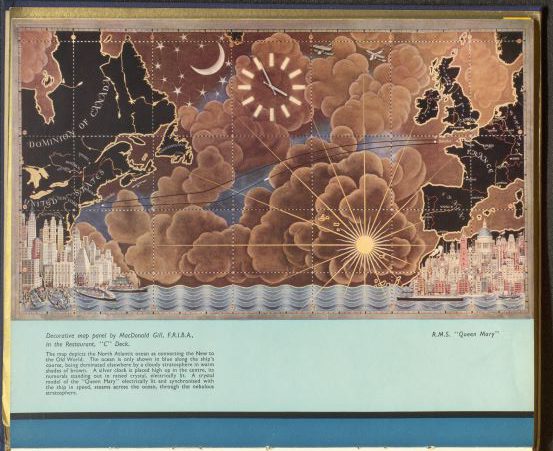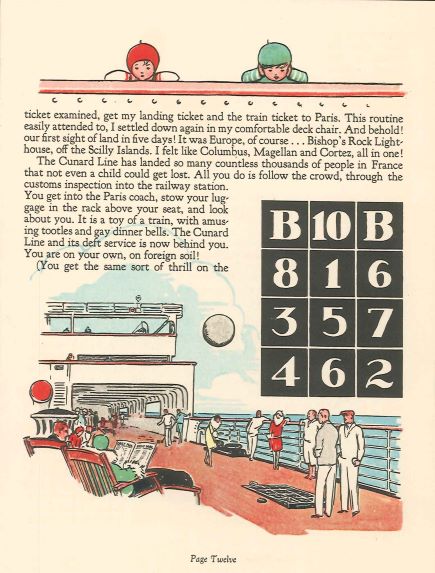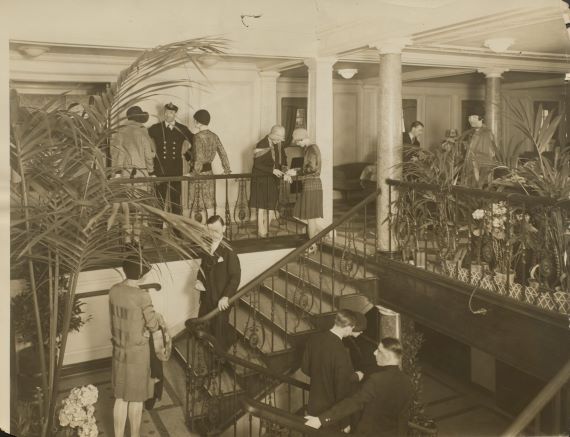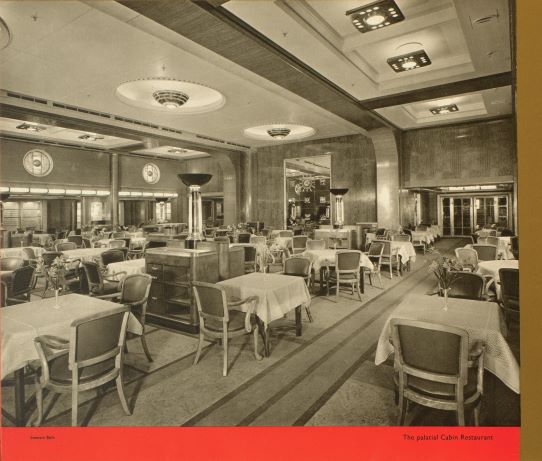In this guest post we hear from Jenny Steele, an artist who visited SC&A to research records from the Cunard archive in preparation for her recent project The Maiden Voyage.

The Maiden Voyage
As a research led artist interested in the development of modernist architecture and design, particularly at the coast, my work often involves having the pleasure of exploring different aspects of history through archival research in a range of locations.
Within my recent project The Maiden Voyage, I have been exploring the design of inter war transatlantic ocean liners that sailed from Liverpool to New York, partly via research at the Cunard Archive at the University of Liverpool Special Collections & Archives. I came to the area of research as I was interested in how the expansion of modernist architecture from Europe to New York is said to have been transported by transatlantic ocean liners via this route during the 1920-30s. This International Modernist style also emulated the design of the machine like ships themselves, referencing the streamlined, curved forms of ocean liners, with nautical details such as masts and portholes.
US President Calvin Coolidge travelled by ocean liner to the Paris Industrial Arts Exposition in 1925, where he viewed examples of modernist architecture and design for the first time. On Coolidge’s return to New York, he supported the construction of forward-thinking modernist architecture in New York. Opulent skyscrapers which emulated the epic scale of the ocean liners, such as The Empire State building were built to demonstrate America’s modernity. This architectural style developed across US east coast cities in municipal and residential buildings, as well as travelling down the coast to Miami Beach where seaside architecture appeared as ships adrift on land with masts and curved corners.
Promises of Adventure
During the inter-war period and before, ‘The Maiden Voyage’ event, of a ship departing the dock for the first time, and indeed any other departure of an ocean liner would stir the population’s imagination significantly. Thousands would line the docks to wave off passengers whether they knew those departing or not. During my visits to the Cunard archive, I viewed several series of images of Maiden Voyage events, including the Queen Mary, which demonstrated by the huge crowds, the social importance of the event. The ship, the most advanced form of available international travel during the inter-war period and before, symbolized foreign lands, adventure and opportunities, but soon the ship itself became the place for adventure itself.
Between the 1860’s and 1930’s, Liverpool was the main UK port for transatlantic travel, predominantly for emigration and cargo between the UK and North America. After the final US immigration act of 1924, it was much harder to gain citizenship within the USA, so emigration passengers dwindled and large shipping companies such as Cunard needed to find ways to attract new clientele for transatlantic travel. Cunard, emulating other European shipping companies, concentrated on constructing high end ‘travelling palaces’ within a new early modernist design style, within which we would now call ‘art deco’. Great emphasis was placed upon health and leisure upon the inter war liners, with swimming pools, tennis courts, areas for walking and shuffleboard, as well as extensive decks for exposure to sea air and heliotherapy.

Modernity and Power
When I initially approached the very helpful staff at the Cunard archive, I had intended to view items only from the well-known Queen Mary (now docked in Long Beach, California) and Queen Elizabeth, but I found there were many more examples of Cunard liners from this era to learn about.
I viewed many promotional pamphlets for ships such as the Mauretania and Ivernia, describing life online as ‘Luxury Afloat’ with accompanying photographs that showed salons, dining rooms, decks and bars. Even in advertisements for the third and tourist classes, despite being the cheapest areas to travel, the interiors were still very stately, with palms and marbled floors. There were also portraits of individuals and group shots of traveler’s, as well as staff of all levels, engineers, cooks and captains. The traveler’s fashions, even in the lower classes were what we associate with the inter war period– cloche hats, drop waist skirts with pleats at the bottom.

Passengers on the second class stairwell of the Aquitania (D42/PR2/1/17/D77) 
The Palatial Cabin Restaurant, Mauretania II (D42/PR10/10G)
I also looked at pamphlets that advertised the Cunard Line in general, and how its ships traveled across the globe with passengers. The language of advertising often used the words ‘strength and power’. The phenomenal scale, strength of engineering and towering presence was significantly visually powerful to those on land, and reassuring safety to those who would be embarking them to travel across water for up to two weeks at a time.
In a brochure for second class cabins, the Cunard ships were described as below:
“The lines of the symmetrical hull, the enormous raking funnels, the tapering masts, and the white upper works and ventilators, and the graceful way in which she sits upon the water, gives this ship the appearance of a colossal yacht”.
“This great power and high speed are mainly responsible for the extreme regularity with which in summer and winter alike, she makes her voyages, passengers being able to reckon with tolerable certainty on the time of arrival”.

I viewed a very interesting booklet within the collection from the 1930’s that demonstrated the mammoth scale of the ships through illustrations comparing the liners against buildings such as the Coliseum in Rome and the British Houses of Parliament. The ships mainly eclipse these mammoth architectural structures. In other booklets I read, the Queen Mary was described as being taller than Niagara Falls and able to travel the Atlantic in 4 days. Other statistics explain the scale of the ship’s operation – 1300 travelers in 3rd class, 500 in 2nd Class and 500 in 1st Class. Staff numbers also demonstrate the gigantic scale of this operation – 50 cooks, 350 stewards, 390 engineers and 70 members of the sailing department on one ship alone. These statistics and facts were designed to calm nervous traveler’s nerves, as well as promote the ships ambitious structure and spirit on land.
Ships from afar
I have been researching my family history this year, mainly through Ancestry, and was pleased to find at least two male ancestors on my maternal side having been employees with the Cunard shipping company. Most recently, my great grandfather who was a cook on Cunard’s SS Servia, between Liverpool and New York, with one record dating him on a passage in 1890. It is both odd, familiar and comforting to think of my great grandfather from the Black Isle in the Highlands in Scotland, embarking to work from Liverpool docks and working in the kitchens underwater for the majority of the passage. And then, disembarking at New York for a rest, no doubt being both fascinated and overwhelmed by what he saw there.
I have also found records of several ancestors on my paternal side making transatlantic passages on both Cunard and White Star ships, less surprising as they were based in Birkenhead on the Wirral.
I have also been recounted a lovely story about how my mother and uncle would watch ocean liners from the cliff perch on Wee Cumbrae island, where they lived in the 1950’s, when my grandfather was one of three lighthouse keepers on the island. At their furthermost perch, the passenger liners, some of which were Cunard liners leaving Clydebank, would travel pass less than half a mile away, on route to North America. They could identify the ships by colours, red and black for Cunard, and over time each individual ship which they would note down the times and dates in a book. The ships weekly presence proved indeed to be powerful promise of other lands, for my Uncle in particular, as a young adult who emigrated to Canada in the 1970’s and then afterwards the USA, where he still lives.
Jenny Steele
Jenny Steele is a Scottish artist currently based in Manchester, UK. Her work references 20th Century architecture, most recently coastal mid war architecture and design. She is interested in how mid war design embodied utopic hope for the future and seeks to revive its restorative and optimistic qualities through her practice that encompasses printmaking, sculpture, drawing, textiles and site-specific artwork.
You can read more about Jenny Steele’s project The Maiden Voyage, in her blog here https://themaidenvoyagejennysteele.wordpress.com/
Jenny also developed her research into a site-specific installation, The Maiden Voyage on George’s Dock Plaza, Liverpool in September 2019, images of which can be viewed on her website.
Twitter & Instagram @jennycsteele